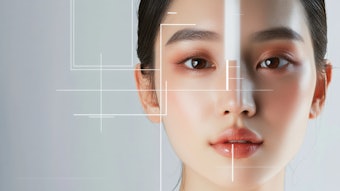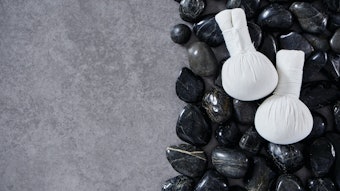
Microcurrent has been called the nonsurgical, or lunchtime face lift, and is a safe and effective, low-cost treatment that counteracts environmental damage, aging skin and poor dietary habits, without invasive surgery. Yet few skin care professionals offer the treatment on their menu. Why?
According to microcurrent expert, esthetician and trainer, Jane Mann, of Skinworks in Las Vegas, “Microcurrent represents a huge missed opportunity for licensed estheticians. Many dermatologists, plastic surgeons and medical spas are not interested in microcurrent; they prefer lasers, injectables or surgery. For the esthetician, microcurrent can be the ultimate anti-aging tool.”
What is microcurrent?
Microcurrent technology is a low-level electrical current that mimics the body’s own biological current. Despite its low electrical vibration—one millionth of an amp—microcurrent treatments are very effective. It helps increase protein synthesis, promote waste removal, stimulate healing, regenerate tissue, balance free radical damage, boost cell growth, enhance natural collagen and elastin production, provide circulatory benefits, and work directly on the nerves and muscle fibers. Its mild frequency does not stimulate sensory nerves, is pain-free and causes no client discomfort.
Also known as facial toning, microcurrent is an esthetic treatment that physically firms and tones the skin through muscle re-education. This process, according to the online article “ATP and Cellular Ageing” by David Suzuki, is achieved by stimulating 32 of the 53 facial muscles at traditional acupuncture points with tiny amounts of electricity to re-energize their biological currents and re-establish muscle memory. The result can be a reduction of fine lines, creases and wrinkles; restored healthy glow of youthful skin; visible firming, contouring and lifting; and the tightening of sagging jowls, double chins and fatty cheeks.
Microcurrent and ATP
As people age, the body’s biological current and chemical energy slows down, cellular renewal takes longer and skin cells stop performing efficiently. This leads to multiple skin problems: loss of tone, elasticity and firmness; fine lines; wrinkles; sagging—all signs of aging. Microcurrent can help reverse this process by re-energizing the synthesis of adenosine triphosphate (ATP).
According to the Suzuki article, ATP, known as the “current of life” or “molecular currency,” is the only energy molecule that the body will accept and utilize as energy. This includes all cellular activity, DNA replication, regeneration and healing, collagen and elastin synthesis, neurotransmission and muscle contraction.
Without ATP, the human body does not function effectively and will eventually deteriorate. Yet, the body does not store ATP; rather it is manufactured on an as-needed basis via ATP synthesis mostly in the mitochondria of the cell. Therefore, the impact of microcurrent to increase levels of ATP is significant. Emil Y. Chi, PhD, director of the University of Washington’s department of pathology, performed clinical studies using microcurrent equipment. He notes, “The fact that technology works in harmony with the body is evident. Examination of the skin tissue treated with microcurrent showed a 45% increase in the number of elastin fibres in the dermis, and the length if the fibres on average doubled. The collagen thickness in the connective tissues increased 10%, and the numbers of blood vessels increased by 35%. The application of microcurrent to skin and tissue produced a firmer and tighter feeling on the skin surface.”
How does microcurrent work?
Knowing how microcurrent technology affects ATP is vital for the success of the treatment, and that means understanding the dynamics of microcurrent’s electrical current, waveform, frequency and polarities.
Electrical current. Microcurrent is measured in microamperes, or µA, which are extremely tiny electrical currents. Microcurrent intensity levels can range from 25–600 µA. A 1982 study called “The effects of electric currents on ATP generation, protein synthesis and membrane transport of rat skin” by Cheng et al., proves that at 500 microamps, ATP generation in the mitochondria increased about 500% and amino acid transport increased by 30–40%. The study also indicated that when currents were increased above 500 microamps, ATP generation was depleted, amino acid uptake was reduced by 20–73% and protein synthesis was inhibited by as much as 50%.
Variety of waveforms. The type of waveform used in microcurrent varies, depending on the area of treatment. Studies indicate that a modified square waveform is best for muscle-lifting, while a slope waveform is better for collagen-building. Other microcurrent waveforms include square and sawtooth.
Microcurrent frequency. “Each cell, tissue and organ has an ideal resonant frequency that coordinates its activities,” says James Oschman, PhD,of Nature’s Own Research Association in Dover, New Hampshire. Microcurrent frequency (Hz) levels can range from 0.1–1,000 Hz. Specific frequencies induce specific effects on cells and other tissues. In the skin, there is a specific frequency for the epidermis and dermis, collagen production and muscles. There is also a specific frequency for each condition, such as inflammation, scars and secretions. Knowing what microcurrent frequency to use is vital for the treatment to resonate and be effective.
Microcurrent polarities. Microcurrent is a biphasic current that alternates between positive and negative using a variety of different tools. These tools can include gloves, probes, rods, pins, wands or masks. Used properly, they enable you to lengthen contracted muscles, as well as shorten elongated muscles, using a series of contouring movements.
According to the aforementioned Chi study, microcurrent can also encourage iontophoresis, or deep penetration of water-based skin care products, increasing the absorption rate of their beneficial ingredients to as much as 70%. It is important to not use oil-based products with microcurrent because they inhibit current flow.
Microcurrent applications
Because microcurrent stimulates the production of ATP, it can be used to treat virtually any skin condition and can be added to any treatment protocol. Microcurrent brings relief to clients with acne by aiding in the elimination of the Propionibacterium acnes (P. acnes) bacteria, and in the reduction of acne scarring. For clients with fine lines, wrinkles, dark circles, baggy eyes and an overall loss of definition, microcurrent can be used as a stand-alone treatment or combined with LED, microdermabrasion or chemical peels to accelerate the reappearance of youthful, beautiful skin. Contraindications for microcurrent include, but are not limited to, heart problems, pacemakers, pregnancy and implanted metal rods.
Clients must be advised to drink additional water before the treatment to allow for proper conductivity of current, and since lymph drainage is activated with microcurrent, clients will feel nauseous if they do not drink a sufficient amount of water after the treatment. Although you can work on any area of the body, do not work on a client for longer than 90 minutes to prevent overloading their system with the stored toxins in their body that will be released. Microcurrent will continue to stimulate ATP levels for 70 hours after treatment. For this reason, it is suggested that you perform the treatment no more than once every three days. Additional treatments will not hurt the client, but are unnecessary. More current is not better and can actually decrease ATP levels because of the overstimulation of cells, so do not tamper with the machine to increase frequency above the manufacturer’s suggested levels.
Results
According to the website of Jeremy E. Kaslow, MD, results can vary by individual and skin type, are gradual, and will not just happen overnight. Some clients notice a difference after the first treatment; others may notice it after three or four treatments. The effect is cumulative, becoming more pronounced after each treatment. The skin and facial muscles become noticeably tighter and more toned with each treatment. About 60–80% of the changes created in one treatment last for the next four to seven days. However, if not treated regularly, the muscles may return to their former configuration.
Although the number of treatments in a series will vary depending on the client’s desired results, the type of equipment used and the complexity of condition, a guideline would be twice per week for the first month, once per week for the second month, or until desired result is achieved, and then once every four to six weeks for maintenance. Although it may be tempting for clients to neglect their check-up visit, gravity, toxins, illness and natural aging will eventually deplete the ATP stockpile if not properly stimulated, so you should emphasize the importance of follow-through to maintain results.
In summation, microcurrent is a versatile device that should be in every skin care professional’s tool box. It offers unlimited possibilities, yet is currently underutilized in the skin care industry. Are you ready to embrace this technology and gain a competitive edge?
General References
“ATP and Cellular Ageing” by David Suzuki, www.bodyclinic.com.au/docs/ATP%20and%20Cellular%20Ageing.pdf
www.novusresearch.com/research/microcurrents.html
www.east-westseminars.com/downloads/HowToChoose.pdf
(All accessed Jul 6, 2011)
Stephanie Frey is the owner of SkinCare Fundamentals, a distributor of fine quality professional skin care products and equipment. Based in the San Francisco/Bay Area, her company offers advanced esthetic workshops to licensed professionals on a wide variety of topics and trains students at local esthetic schools on how to use different treatment protocols and current state-of-the art technology.










